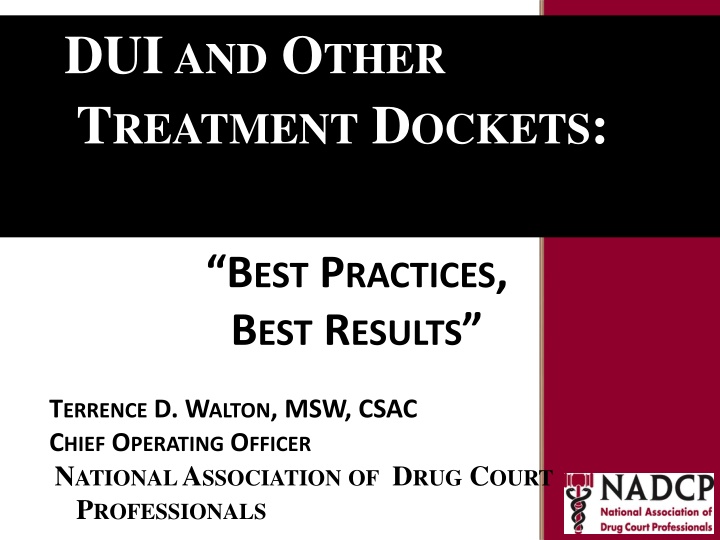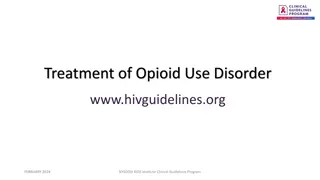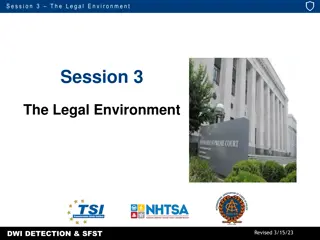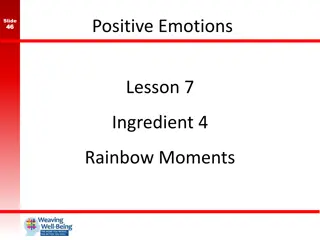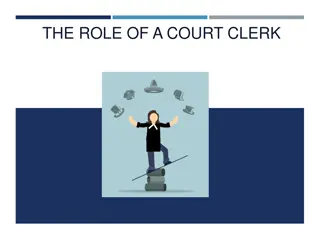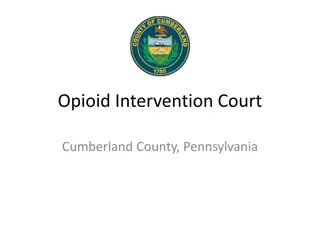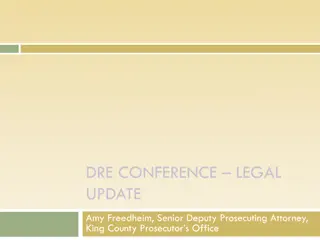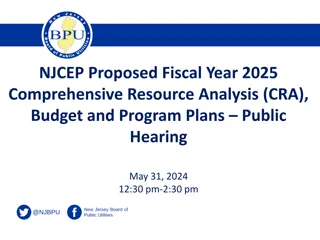Key Moments in NADCP History: DUI & Treatment Dockets - Best Practices & Results
Significant moments in NADCP history related to DUI and treatment dockets, highlighting best practices and outcomes. Understand the importance of defining standards for Drug Courts to enhance accountability and effectiveness, ultimately improving outcomes for participants. Learn about the adoption of standards in various states and the impact on the treatment landscape. Discover insights on complementary treatments and social services in enhancing overall participant compliance and reducing recidivism.
Download Presentation

Please find below an Image/Link to download the presentation.
The content on the website is provided AS IS for your information and personal use only. It may not be sold, licensed, or shared on other websites without obtaining consent from the author.If you encounter any issues during the download, it is possible that the publisher has removed the file from their server.
You are allowed to download the files provided on this website for personal or commercial use, subject to the condition that they are used lawfully. All files are the property of their respective owners.
The content on the website is provided AS IS for your information and personal use only. It may not be sold, licensed, or shared on other websites without obtaining consent from the author.
E N D
Presentation Transcript
Key Moments in NADCP History DUI AND OTHER TREATMENT DOCKETS: BEST PRACTICES, BEST RESULTS TERRENCE D. WALTON, MSW, CSAC CHIEF OPERATING OFFICER NATIONAL ASSOCIATIONOF DRUG COURT PROFESSIONALS
Key Moments in NADCP History Why Standards?
Key Moments in NADCP History Why Standards? Until Drug Courts define appropriate standards of practice, they will be held accountable, fairly or unfairly, for the worst practices in the field. Scientists will continue to analyze the effects of weak Drug Courts alongside those of exceptional Drug Courts, thus diluting the benefits of Drug Courts. Critics will continue to tarnish the reputation of Drug Courts by attributing to them the most noxious practices of the feeblest programs. Only by defining the bounds of acceptable and exceptional practices will Drug Courts be in a position to disown poor-quality or harmful programs and set effective benchmarks for new and existing programs to achieve.
Key Moments in NADCP History Volume I I. Target Population II. Historically Disadvantaged Groups III. Roles & Responsibilities of the Judge IV. Incentives, Sanctions, & Therapeutic Adjustments V. Substance Abuse Treatment
Key Moments in NADCP History Volume I Twenty out of twenty-five states (80%) responding to a national survey indicated they have adopted the Standards for purposes of credentialing, funding, or training new and existing Drug Courts in their jurisdictions.
Key Moments in NADCP History Volume II VI. Complementary Treatment & Social Services VII.Drug and Alcohol Testing VIII.Multidisciplinary Team IX. Census and Caseloads X. Monitoring and Evaluation
Key Moments in NADCP History Complementary Treatment Participants receive complementary treatment and social services for conditions that co-occur with substance abuse and are likely to interfere with their compliance in Drug Court, increase criminal recidivism, or diminish treatment gains.
Key Moments in NADCP History Complementary Treatment N = 21 reviewers high 3.81 4.57 4.48 5 4 3 2 1 low Clarity Justification Feasibility
Key Moments in NADCP History Complementary Treatment A. Scope of Services B. Sequence and Timing of Services C. Clinical Case Management D. Housing Assistance E. Mental Health Treatment F. Trauma-Informed Services
Key Moments in NADCP History Complementary Treatment G. Criminal Thinking Interventions H. Family & Interpersonal Counseling I. Vocational & Educational Services J. Medical and Dental Treatment K. Prevention of High-Risk Behaviors L. Overdose Prevention & Reversal
Complementary Treatment 1) Do not begin criminal thinking interventions during Phase 1. 2) Enlist at least one reliable prosocial family member, friend, or daily acquaintance to provide feedback to staff and assist participant.
Key Moments in NADCP History Timing Matters Responsivity Criminogenic Maintenance Needs Needs Needs Early Middle Late
Key Moments in NADCP History Drug & Alcohol Testing Drug and alcohol testing provides an accurate, timely, and comprehensive assessment of unauthorized substance use throughout participants enrollment in the Drug Court.
Key Moments in NADCP History Drug & Alcohol Testing N = 36 reviewers high 4.86 4.19 4.42 5 4 3 2 1 low Clarity Justification Feasibility
Key Moments in NADCP History Drug & Alcohol Testing A.Frequent Testing B.Random Testing C.Duration of Testing D.Breadth of Testing E.Witnessed Collection
Key Moments in NADCP History Drug & Alcohol Testing F. Valid specimens G.Accurate & Reliable Testing Procedures H.Rapid Results I. Participant Contract
Drug and Alcohol Testing 1) Randomly test at least twice per week, including weekends and holidays and require participants to report within 8 hours of notification. 2) Continue testing randomly at least twice per week until participant is preparing for graduation in the final phase.
Key Moments in NADCP History Avoid Respites from Detection A participant should have an equal chance of being called on any day of the week. Avoid randomizing in weekly blocks. Test routinely for all drugs commonly used by population.
Key Moments in NADCP History Multidisciplinary Team A dedicated multidisciplinary team of professionals manages the day-to-day operations of the Drug Court, including reviewing participant progress during pre-court staff meetings and status hearings, contributing observations and recommendations within team members respective areas of expertise, and delivering or overseeing the delivery of legal, treatment and supervision services.
Key Moments in NADCP History Multidisciplinary Team N = 21 reviewers high 4.80 4.50 4.71 5 4 3 2 1 low Clarity Justification Feasibility
Key Moments in NADCP History Multidisciplinary Team Pre-Court Staff Meetings & Status Hearings Composition & Training Team Communication & Decision Making Sharing Information
Multidisciplinary Team 1) Judge considers perspectives of all team member before making decisions that impact participants welfare or liberty interests. 2) Defense attorneys inform participants and team members whether they will share confidential information concerning participants with other team members.
Key Moments in NADCP History Census and Caseloads The Drug Court serves as many eligible individuals as practicable while maintaining continuous fidelity to best practice standards.
Key Moments in NADCP History Census and Caseloads N = 26 reviewers high 4.38 4.15 4.19 5 4 3 2 1 low Clarity Justification Feasibility
Key Moments in NADCP History Census and Caseloads Drug Court Census Supervision Clinician Caseloads Caseloads
http://www.toahigherlevel.com/wp-content/uploads/2015/04/2-Big-Things-300x225.jpghttp://www.toahigherlevel.com/wp-content/uploads/2015/04/2-Big-Things-300x225.jpg High Risk 30 to 1 (or less) Low Risk Probation: 50 to 1 Treatment: 30: 1 200:1 Census and Caseloads 1) Program census, as well as supervision and treatment caseloads are small enough to permit both reliable detection of behavior and effective responses. 2) Caseload sizes relate to the risk and need levels of participants. Need Treatment: 50: 1 High Need Probation: 30 to 1 Low Don t Belong in Drug Court
Key Moments in NADCP History Monitoring & Evaluation The Drug Court routinely monitors its adherence to best practice standards and employs scientifically valid and reliable procedures to evaluate its effectiveness.
Key Moments in NADCP History Monitoring & Evaluation N = 32 reviewers high 4.42 3.34 4.34 5 4 3 2 1 low Clarity Justification Feasibility
Key Moments in NADCP History Monitoring & Evaluation A.Adherence to Best Practices B. In-Program Outcomes C. Criminal Recidivism D.Independent Evaluations E. Historically Disadvantaged Groups
Key Moments in NADCP History Monitoring & Evaluation F. Electronic Database G.Timely & Reliable Data Entry H.Intent-to-Treat Analyses I. Comparison Groups J. Time at Risk
Monitoring and Evaluation 1) Analyze outcomes for all participants, including those who withdrew or were terminated early. 2) Staff members are required to record information regarding service provision within 48 hours.
Key Moments in NADCP History DUI AND OTHER TREATMENT DOCKETS: BEST PRACTICES, BEST RESULTS TWALTON@ALLRISE.ORG
